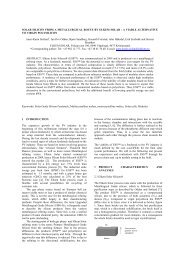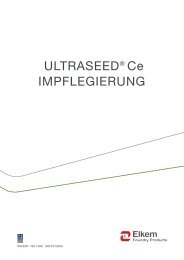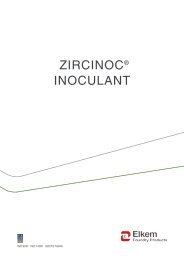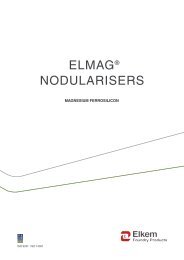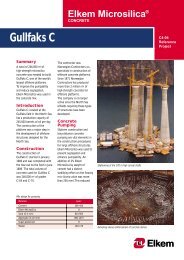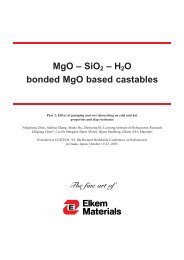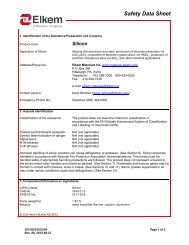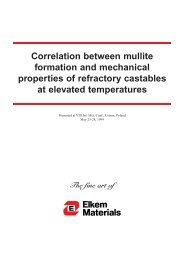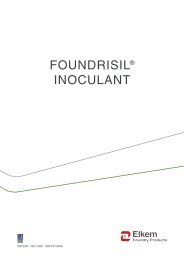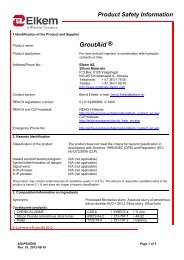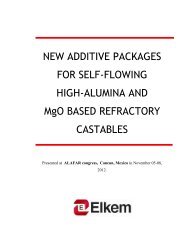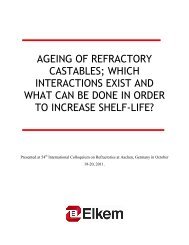Microsilica containing refractory castables - Elkem
Microsilica containing refractory castables - Elkem
Microsilica containing refractory castables - Elkem
Create successful ePaper yourself
Turn your PDF publications into a flip-book with our unique Google optimized e-Paper software.
MICROSILICA CONTANINGREFRACTORY CASTABLES-INFLUENCE OF ADDITIVESON PLACING PROPERTIESPresented at the 47 th annual symposium on Additives for monolithics, at St.Louis, USA, March 23-24, 2011.
<strong>Microsilica</strong> <strong>containing</strong> <strong>refractory</strong> <strong>castables</strong> - the influence ofadditives on placing propertiesBjørn Myhre,<strong>Elkem</strong> Silicon Materials, P.O Box 8126 Vaagsbygd,4675 Kristiansand, Norway.bjorn.myhre@elkem.noAbstract:The surface of microsilica is covered by numeroussilanol groups that are able to dissociate in anaqueous medium. The dissociation is responsiblefor interactions in <strong>castables</strong> with microsilica andcement.When microsilica is used in <strong>castables</strong> suchinteractions are normally modified by use of asuitable additive. The additive disperses, but theamount and type may have side-effects that may notbe expected. Both set time as well as ageing of thecastable has been found very dependent on type andamount of additive. In this paper some of theinteractions in microsilica <strong>containing</strong> <strong>castables</strong> areshown and explained.Surface of <strong>Microsilica</strong>Although the overall composition of microsilica isSiO 2 , the surface of a microsilica particle is notplain siloxane bonds, but is also partiallyhydroxylated and hydrated. Producers of fumedsilica (particularly Evonik Degussa) have been veryactive in the characterisation and modification ofthe silica surface in order to tailor specificproperties of precipitated and fumed silica.In general, several connectivities of surface siliconhave been identified by means of FT-IR- and NMRspectroscopy,as shown in Figure 1.Figure 1. Surface Si connectivities idientified on silica.
Based on theoretical and experimental results 1 , itseems that the maximum density of silanol (Si-OH)groups on the surface of silica is approximately4.6nm -2 .The surface of microsilica is covered by silanolgroups; although the presence of impurities playssome role, measurements have indicated silanoldensities ranging from approximately 2 to 4.5nm -2for microsilica from silicon production. The goodcorrelation between theoretical values and thosefound for microsilica may indicate that theimpurities of the microsilica are not smothered outon the surface of the microsilica particles but ratheras discrete particles or dissolved in the silica. Acombination is probable.The presence of the silanol groups makes themicrosilica easy to disperse in aqueous systems.Depending on the pH, a fraction of the silanolgroups dissociate resulting into a negativelycharged surface. The surface charge or zetapotentialcan be measured and values higher thanapproximately 25mV (positive or negative) areoften taken as an indication of stable suspensions.Figure 2 shows a measurement of such a zetapotential for microsilica 971, and we see that themicrosilica has a negative charge over the wholerange. Due to dissociation of the silanol groups, thenegative surface charge increases with pH up toapproximately pH 7. At higher pH than 7, the zetapotential flattens out and at still higher pH themicrosilica starts to dissolve.Additional to the microsilica, <strong>refractory</strong> <strong>castables</strong>often contain reactive alumina in combination withmicrosilica. Looking at the Zeta-potential of thealumina, being positive over most of the range,Figure 3, one could expect that microsilica andalumina would attach and flocculate due to theopposite charges. In practice this does not happenas the pH of castable mixes normally are on thebasic side of neutral where the alumina has verylow or even negative surface charge.Zeta-potential (mV)40.035.030.025.020.015.010.05.00.0-5.0CTC50 titrated by 1M HCl0.00 2.00 4.00 6.00 8.00 10.00Figure 3 Zeta potential of Alumina CTC50 fromAlmatis as a function of pH. A 10% slurry titratedwith HCl and with zeta potential being measuredusing electro-acoustic techniques (Acoustosizer,Collodial Dynamics)pHZeta-potential (mV)0.0-5.0-10.0-15.0-20.0-25.0-30.0-35.0-40.0MS titrated by 1M HCl0.00 2.00 4.00 6.00 8.00Figure 2 Zeta potential of microsilica 971 as afunction of pH. A 10% microsilica slurry titratedwith HCl and with zeta potential being measuredusing electro-acoustic techniques (Acoustosizer,Collodial Dynamics)pH<strong>Microsilica</strong> and deflocculantsA <strong>refractory</strong> castable can be visualised as anaggregate structure with voids filled by aqueousslurry of microsilica, cement and other fines. Thenegative charge of the microsilica makes itvulnerable for “attack” by cations which causesgelling or solidification of the system. Theconcentrations necessary for gelling are dependingon type of cation but a quick calculation of thenumber of sites (silanol groups) per grammicrosilica estimates that approximately 0.15mmolper gram of microsilica could be sufficient for a fullcoverage. This quantity is in many (less pure)microsilicas available as water soluble impurities inthe microsilica itself, and an autogenous gelling ofsuch a slurry (e.g. 50%) may occur. Although anycation can be used for gelling microsilica slurry, the
characteristics of the resultant slurry are dependenton the charge and size of the cation that attaches. Inthe case of monovalent cations, the gelling actionhas been attributed to a mechanism where it’s thehydrated cations that link adjacent silica particles.Such a gel normally feels quite “soft” and easy toliquify by agitation, while that from polyvalentcations tend to have a more “brittle” and “harder”appearance. With polyvalent cations, it is easy toimagine that the excess positive charge of thecation links with another negative charge on anadjacent microsilica particle. In this way threedimensionalnetworks may form and this is whatwe normally regard as gelled microsilica.In <strong>castables</strong>, cations are generally available fromthe cement and aggregates, and it is likely that theinitial setting of most <strong>castables</strong> is closely related togelling of the microsilica <strong>containing</strong> slurry phase.In the case of ultralow and no-cement systems withmicrosilica, it is probable that most of the setting isdependent of this solidification although it is oftentriggered by small amounts of additives thatpromote the gelling. Such additives can e.g. besmall quantities of cement.The absorption of polyvalent cations on the silanolsites is most likely a dynamic process and requiresa certain concentration in the water phase beforeabsorption gets significant. The amounts of solublecations necessary for gelation are thereforeprobably higher than just to attach to the silanolsites, but it seems reasonable to expect that theorder of magnitude may be similar.The tendency to react with cations to produce amore or less rigid gel, creates problems if used indensely packed castable systems where cement ispresent. The calcium and aluminate cations fromthe cement dissolve and attack the otherwise fluidbond phase. To prevent this coagulation, thecalcium ions have to be prevented from absorbingon the microsilica. This may either be done byhaving a pH below 5, but as this may affect setting;addition of a proper amount of a polyelectrolyte ora surface active agent is a common stratagem. Thesurface active agent, normally termed deflocculant(in Portland cement based systems termedplasticiser or superplasticiser), is believed to absorbto the surfaces thus preventing the absorption ofcalcium but it also creates an equal, often negativecharge of the particles of the bond system. As theparticles then will repel each other, casting can takeplace at reduced water additions. Deflocculantscommonly used are polyphosphates, e.g. sodiumhexametaphosphate (Calgon) at approximately 0.2wt% addition level, and polyacrylates (Darvan811D, 0.05 wt %). The effect of Calgon onmicrosilica and reactive alumina is illustrated inFigure 4.Zeta-potential (mV)0.0-10.0-20.0-30.0-40.0-50.0-60.0-70.00 0.5 1 1.5 2 2.5Surfactant content (mg/m2)10% MS Slurry 5% Calgon10% CTC50 slurry 5% CalgonFigure 4: The effect of addition of Calgon. Zetapotential of 10% aqueous slurry of microsilica 971or CTC50 as a function of Calgon additionexpressed as mg/m 2 surface.The deflocculating mechanisms involved fallsnormally into two main groups or combinationthereof:1) Steric stabilisation, the deflocculant attaches tothe fines and the size of it preventsagglomeration of particles2) Electrostatic stabilisation, the deflocculantcreates an equal electrical charge on thesurface of the fines. Electrostatic repulsionprevents particles from agglomeration.3) Combination of 1) and 2):Additional to the above mechanisms, use ofdeflocculants makes it possible to maintain flow of<strong>refractory</strong> <strong>castables</strong> for some time, sufficient toplace the castable before setting (gelling)commences. Sometimes setting may get adverselyaffected though, giving unacceptably long or shortset times. This has been explained with severalmechanisms. For long set time withpolycarboxylate ethers, one explanation is that thesurface of the cement get “shielded” by the side
chains and that longer side chains consequentlyretard more than shorter 2 .Deflocculants and flow:To check quality of microsilica or cement or othercomponents of low cement <strong>castables</strong>, <strong>Elkem</strong> hassince the early 1990’ies, used a model LCC basedon white fused alumina with 6% CAC and 8%microsilica. The castable is composed to follow anAdreassen type PSD with a q-value close to 0.25giving flow properties close to self-flowing at4.15wt% water (=13 volume %). The castablecomposition is given in Table 1.Table 1 Standard LCC castable composition.[wt%]<strong>Microsilica</strong> (18 or 24 m 2 /g) 8CA-14 [wt%] 6White Fused Alumina. 3-5mm 10White Fused Alumina. 0,5-3 mm 32White Fused Alumina. 0-0,5mm 16White Fused Alumina. -74 micron 12Calcined alumina: CT 9FG 16Deflocculant: Castament FS20 0,01-0,1*Water [wt%] 4.15* Standard dosage, 0.05%To check the effect of the Castament FS20 on flowof a castable, the standard LCC mix (Table 1) wasused with the amount of deflocculant as thevariable. Two different microsilica qualities withsurface area of 18 and 24m 2 /g were used. In Table1, the composition of this mix is given. In Figure 7,the resultant self-flow values are shown as afunction of deflocculant addition per microsilicasurface area (mg/m 2 ).The two microsilica qualities gives very similarresults when expressed as a function of surfacearea, only the maximum self flow differssomewhat. Although lower self flow was obtainedwith the microsilica with the higher surface area,and conclusions in the direction of lower flow athigher surface area would be tempting, we do nothave data proving that this actually is the case.Self-flow (%)10090807060504030201024 m 2 /g00 0.2 0.4 0.6 0.8FS20 dosage (mg/m2)18 m 2 /gFigure 5. Self flow of white fused alumina basedLCC as a function of deflocculant addition.Effect of dispersantAbove, the good correlation between microsilicasurface area, flow and amount of additive wasshown. Those findings were based on flowmeasurements of LCC based on fused alumina, butthe same correlations exist for bauxite basedsystems.Table 2: Bauxite based LCC compositions.(%) 1 2Chinese bauxite 1-30 304mmChinese bauxite 0-30 301mmFused Al. -74 mic 18 18Secar 71 6 6Calcined alumina 8 8<strong>Microsilica</strong> (971U) 8 8FS20 0.01-0.15Calgon 0.01-0.40Water 5.50 5.50In Figure 6, self-flow of castable 1 and 2 (Table 2)is presented as a function of addition of dispersantin mg per square meter microsilica surface. Inpractical terms, an addition of 1 mg/m 2 equals to anaddition level of approximately 0.2%.Earlier results on white fused aluminasystems(Table 1) have shown similar dependenciesfor FS20 and Calgon, as shown in Figure 7.
120100FS20Calgon120100FS20CalgonDarvan 811DSelf-flow (%)806040Self-flow (%)806040202000.00 0.50 1.00 1.50 2.00 2.50 3.00Dosage (mg/m 2 )Figure 6: Effect of dosage of dispersants on selfflowof bauxite-based LCC (number 1&2 in Table2).If Figure 6 and 7 are compared, it is seen that forFS20 the appearance is quite similar, while forCalgon it is in principle similar, but somewhatskewed. There can be several reasons for theslightly distorted shape of the curve for Calgon, butthe first that come into mind is that the phosphatereacts with impurities of the bauxite, thusnecessitating higher dosages than in the purer whitefused alumina system. Further, as also Darvan811D is included, it should be commented.Darvan being a poly-acrylate as opposed to FS20being a carboxylate-ether differs by having apronounced optimum addition level as opposed tothe more flat plateau level that is seen for FS20.This is probably connected to the mode ofstabilisation of colloidal slurries of the twodifferent additives. Darvan is by electrostaticrepulsion, FS20 by a combined steric andelectrostatic mechanism.00 0.5 1 1.5Dosage (mg/m 2 )Figure 7: Effect of dispersant addition on self flowof white fused alumina based <strong>castables</strong> with 6%cement and 8% microsilica, 4.15% water.If we look at the Zeta-potential for the combinationof microsilica and the additives in question thefollowing is found, Figure 8.Zeta-potential (mV)0-10-20-30-40-50-60-70-80-900 0.5 1 1.5 2Surfactant content (mg/m2)FS20Darvan 811DCalgonFigure8: Zeta potential of 10% aqueous slurry ofmicrosilica 971 as a function of dispersant additionexpressed as mg/m 2 microsilica surface.Figure 8 shows the zeta-potential of a microsilicaslurry as a function of dispersant addition. Here,Darvan 811D, Calgon and FS20 have been tested.Two phenomena may be noticed, firstly thelowering (or lack of it) of zeta-potential caused byFS20 indicates that the stabilisation mechanism isprimarily of steric (uncharged) nature. The secondobservation is that there is a good correlationbetween the zeta-potential and the flow. This issuch that the maximum flow appears at, or close to,the point of the relevant zeta-potential curve whereit either attains minimum or, in the case of Darvan,the slope changes abruptly.
Set of microsilica <strong>containing</strong> <strong>castables</strong>Up to the first half of the 1980’ies, the commonway of determining set time of <strong>refractory</strong> <strong>castables</strong>was by assessing set with the use of a Vicat-needleset up, or less sophisticated methods likeassessment by knocking, squeezing etc. All thesemethods had a number of difficulties, of which thelabor and lack of precision when used on <strong>castables</strong>ystems was the most important.In 1984, Fentiman, George and Montgomery 3 ,correlated results from Vicat measurements withtemperature development of <strong>castables</strong>.Instead of using a Vicat needle (penetration of aneedle into fresh mortar) the temperature of thecastable (or mortar) is recorded. Adiabaticcalorimetric studies of aluminous cement in contactwith water have shown that there are twoexotherms. The first occurs immediately and isassociated with heat of wetting and rapiddissolution. A dormant period then follows duringwhich hydrate nuclei form and develop. Oncecritical nuclei have been formed, bulk precipitationof hydrate occurs giving rise to a second exotherm 4 .This second exothermic reaction may be used todetermine when the setting starts by simplyembedding a thermocouple into a proper amount offresh castable or mortar. If the thermocouple isconnected to a strip-chart recorder, the exothermmanifests as a temperature increase. The time toinitial set(TTS) may thus be measured (Fig. 9). Thetime to temperature increase correlates well withdata obtained by the Vicat needle. Figure 10 showsa typical exotherm and the correlation betweenVicat and the exothermic test. The exothermic testcan, as opposed to the Vicat needle, also givereliable results when applied on <strong>castables</strong>.TimeTTMTTSSTARTFigure 9. Typical Strip-chart print out showingtemperature in a microsilica <strong>containing</strong> CA-cementbased <strong>refractory</strong> castable.Figure 10.Correlation between Vicat initial set andresults from exothermic test for calcium aluminatemortar.For <strong>castables</strong> with both microsilica and CA-cement,the castable normally shows an additionalexotherm, which has been associated with theformation of a layer of CASH compounds on thesurface of the cement particles that dissolves andenables setting to proceed, giving the finalexotherm 5 . Usually, the appearance of the firstexotherm (TTS) is associated with the end ofworkability of the castable, and the maximumtemperature of the second exotherm (TTM) isregarded as the time to final set. The temperaturemethod has been found easy and reliable, but is notsuited for <strong>castables</strong> with very low cement contentbecause of the small amount of heat liberated. Theminimum cement content for reliablemeasurements may be around 3-5% depending onsample size and apparatus.At UNITECR 2005 in Orlando, Myhre 6 presented astudy in which some interesting correlationsbetween microsilica and set time were shown. Thesystem investigated was based on the standardcastable composition given in Table 1, with themicrosilica quality as the variable. All microsilicasamples came from the same source, but taken atdifferent occasions during a period of a few monthsfor two successive years. In this context it must bestressed that the microsilica in question is anuncontrolled grade, collected as a by-product fromsilicon production. To further emphasise this point,the original figure from Orlando has beenmanipulated to also include results from mixesusing the controlled microsilica grade 971 sampledand tested during the same months but in 2007.
36:00 12:0030:00 6:0020042005971-200728:48:0024:00:00FS20CalgonDarvan 811DTTS [h:min]24:00 0:0018:0012:00TTS (h:min)19:12:0014:24:009:36:006:004:48:000:0024/1 3/2 13/2 23/2 4/3 14/3 24/3Sampling dateFigure 11. Initial set as a function of productiondate for microsilica from one silicon furnace duringwinter/spring 2004 and 2005. Values obtained withmicrosilica grade 971 is added for reference.The set time as defined by the time to the firstexotherm of the castable, TTS, shows a verypronounced dependency on the addition level, withCalgon being the prominent example. In Figure 12and 13 the set time is shown for the bauxite and thewhite fused alumina system, respectively. In bothcases the set time of the Calgon dispersed <strong>castables</strong>has a very long set time at addition levels around0.35mg/m 2 . This coincides in the white fusedalumina example unfortunately also with themaximum flow. In the bauxite example, as themaximum flow was obtained at higher Calgonadditions this is no longer a problem. FS20 shows aflatter response to the addition level, although byvery high addition level there is a tendency towardsprolonged set.TTS (h:min)24:0020:2416:4813:129:366:002:240.00 0.50 1.00 1.50 2.00 2.50 3.00Dosage (mg/m 2 )FS20CalgonFigure 12 The effect of dispersant addition on settime of bauxite based LCC (1 & 2 Table 1)0:00:000.00 0.30 0.60 0.90 1.20 1.50Dosage (mg/m 2 )Figure 13: Effect of additive on set time of thewhite fused alumina based LCC.If the two different systems are compared, at thesame addition level, the two systems reactsimilarly, yielding similar set times and flowvalues. The bauxite however needs more water (5.5as compared to 4.15).Shelf lifeShelf life of castable 1 and 2( Table 2) with 0,05%FS20 and 0,20% Calgon respectively, wasmeasured on dry-mixed samples (25kg, 6minutes inHobart mixer) placed in closed, plastic lined paperbags. Two conditions were chosen, one was anunheated warehouse at the <strong>Elkem</strong> site inKristiansand Norway, the other was in atemperature and humidity controlled room,>50%RH at 20°C. The differences between the twoconditions were thus that the warehouse fluctuatedwith the weather and seasons while the climateroom had close to constant conditions withrelatively high humidity. This controlled conditionhas earlier been found to accelerate ageingsignificantly and is used in accelerated ageing testsin <strong>Elkem</strong>. In Figure 14 the self-flow of the <strong>castables</strong>are shown as a function of storage time.Although not having a very strong effect on flow,some lowering in self-flow is seen particularly forthe Calgon samples after extended storage in theclimate room.In Figure 15, the set time as expressed by the timeto the first exotherm (TTS) is shown as a functionof storage time.As opposed to the flow, the storage has a strongeffect on set time. Already after 30 days of storage,the set time increases significantly for bothdispersants at both storage conditions. While the
FS20 then becomes relatively stable, the sampleswith Calgon continues the trend towards longer andlonger set time. The set time of the samples in theclimate controlled room seems the most affected,extending the set time up to 4 days in the worstcase.phosphates could be an option. The humidity wouldassist these processes if not take active part. Suchassumptions must be thoroughly investigated inseparate tests though.10080FS20Calgon96:00:0076:48:00FS20CalgonSelf-flow (%)6040TTS (h:min)57:36:0038:24:002019:12:000Start point 30 90 180Storage time (days)0:00:00Start point 30 90 180Storage time (days)(a) Stored in warehouseSelf-flow (%)100806040200(a) Stored in warehouseFS20CalgonStart point 30 90 180Storage time (days)(b) >50% RH at 20 o CTTS (h:min)96:00:0076:48:0057:36:0038:24:0019:12:000:00:00FS20CalgonStart point 30 90 180Storage time (days)(b) >50% RH at 20 o CFigure 15: Set-time of bauxite LCC after storage ina) warehouse in Kristiansand and b) >50% RH at20 o C, respectivey.Figure 14: Self-flow of bauxite LCC after storage:a) warehouse in Kristiansand and b) the climatecontrolled room at >50% RH and 20 o C,respectively.According to Fryda et al. 7 , humidity is a key factorin ageing, and this is also shown here as the highhumidity in the climate controlled room acceleratesdecay as compared to the warehouse condition.Very interesting is the difference in behaviourbetween Calgon and FS20. To explain this wouldimply some speculations, but immunisation orsealing of the cement surface by calciumConclusion.Because of interactions between cement andmicrosilica, additives has to be used in order toensure good flow of a castable. The flow of thecastable is then dependent on the proper amount ofadditive, and the set is dependent on it as well. Theoptimum addition level is not always easy topredict as sometimes there are opposite effects, likethe example with Calgon that has long set time atoptimum flow. It may therefore be concluded thatconcerning flow and set, one will often face atradeoff between the desired properties. Alsoregarding shelf life of <strong>castables</strong>, it is not
insignificant what choice is made. Choosing oneadditive over another may in some cases be on theexpense of the longevity of the castable.References:1 R.K. Iler, “The chemistry of silica”, John Wiley& Sons, New York 1979.2 H. Hommer and K. Wutz:” Recent Developmentsin Deflocculants for Castables” in procUNITECR’05, Am. Ceram Soc. p.186-1903 C.H. Fentiman et. al in " Advances in Ceramicsvol. 13, New Developments in MonolithicRefractories" ed. by Robert E. Fisher, The Am.Ceram. Soc. Inc. Columbus, Ohio 1985 p. 131-1354 L. S. Wells and E. T. Carlson; J. Res. Natl. Bur.Stand., RP2723, 57, 335 (1956)5 Steffen Möhmel: in “ Die Reaktionen vonCalciumaluminaten bei Hydratation undthermischer Belastung – Beiträge zur Chemie derHochtonerdezemente” dr. ing thesis Tech. Univ.Freiberg Germany 2003.6 B.Myhre, ” <strong>Microsilica</strong> in Refractory Castables-How does <strong>Microsilica</strong> Quality influenceperformance?” in proc. UNITECR 2005 OrlandoUSA Nov. 9, 20057 Fryda et al., “A New Insight into theCharacterisation of Ageing and Mechanisms ThatDetermine the Shelf Life of Low CementCastables“ in Proc UNITECR 2009, SalvadorBrasil Oct 13-16 2009.



